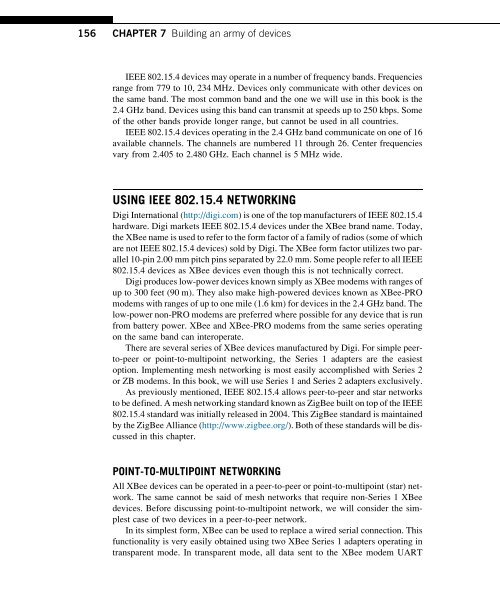Hacking_and_Penetration_Testing_with_Low_Power_Devices
Create successful ePaper yourself
Turn your PDF publications into a flip-book with our unique Google optimized e-Paper software.
156 CHAPTER 7 Building an army of devices<br />
IEEE 802.15.4 devices may operate in a number of frequency b<strong>and</strong>s. Frequencies<br />
range from 779 to 10, 234 MHz. <strong>Devices</strong> only communicate <strong>with</strong> other devices on<br />
the same b<strong>and</strong>. The most common b<strong>and</strong> <strong>and</strong> the one we will use in this book is the<br />
2.4 GHz b<strong>and</strong>. <strong>Devices</strong> using this b<strong>and</strong> can transmit at speeds up to 250 kbps. Some<br />
of the other b<strong>and</strong>s provide longer range, but cannot be used in all countries.<br />
IEEE 802.15.4 devices operating in the 2.4 GHz b<strong>and</strong> communicate on one of 16<br />
available channels. The channels are numbered 11 through 26. Center frequencies<br />
vary from 2.405 to 2.480 GHz. Each channel is 5 MHz wide.<br />
USING IEEE 802.15.4 NETWORKING<br />
Digi International (http://digi.com) is one of the top manufacturers of IEEE 802.15.4<br />
hardware. Digi markets IEEE 802.15.4 devices under the XBee br<strong>and</strong> name. Today,<br />
the XBee name is used to refer to the form factor of a family of radios (some of which<br />
are not IEEE 802.15.4 devices) sold by Digi. The XBee form factor utilizes two parallel<br />
10-pin 2.00 mm pitch pins separated by 22.0 mm. Some people refer to all IEEE<br />
802.15.4 devices as XBee devices even though this is not technically correct.<br />
Digi produces low-power devices known simply as XBee modems <strong>with</strong> ranges of<br />
up to 300 feet (90 m). They also make high-powered devices known as XBee-PRO<br />
modems <strong>with</strong> ranges of up to one mile (1.6 km) for devices in the 2.4 GHz b<strong>and</strong>. The<br />
low-power non-PRO modems are preferred where possible for any device that is run<br />
from battery power. XBee <strong>and</strong> XBee-PRO modems from the same series operating<br />
on the same b<strong>and</strong> can interoperate.<br />
There are several series of XBee devices manufactured by Digi. For simple peerto-peer<br />
or point-to-multipoint networking, the Series 1 adapters are the easiest<br />
option. Implementing mesh networking is most easily accomplished <strong>with</strong> Series 2<br />
or ZB modems. In this book, we will use Series 1 <strong>and</strong> Series 2 adapters exclusively.<br />
As previously mentioned, IEEE 802.15.4 allows peer-to-peer <strong>and</strong> star networks<br />
to be defined. A mesh networking st<strong>and</strong>ard known as ZigBee built on top of the IEEE<br />
802.15.4 st<strong>and</strong>ard was initially released in 2004. This ZigBee st<strong>and</strong>ard is maintained<br />
by the ZigBee Alliance (http://www.zigbee.org/). Both of these st<strong>and</strong>ards will be discussed<br />
in this chapter.<br />
POINT-TO-MULTIPOINT NETWORKING<br />
All XBee devices can be operated in a peer-to-peer or point-to-multipoint (star) network.<br />
The same cannot be said of mesh networks that require non-Series 1 XBee<br />
devices. Before discussing point-to-multipoint network, we will consider the simplest<br />
case of two devices in a peer-to-peer network.<br />
In its simplest form, XBee can be used to replace a wired serial connection. This<br />
functionality is very easily obtained using two XBee Series 1 adapters operating in<br />
transparent mode. In transparent mode, all data sent to the XBee modem UART


